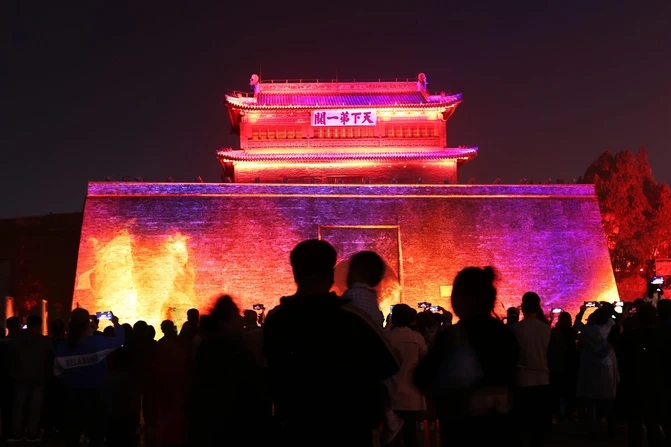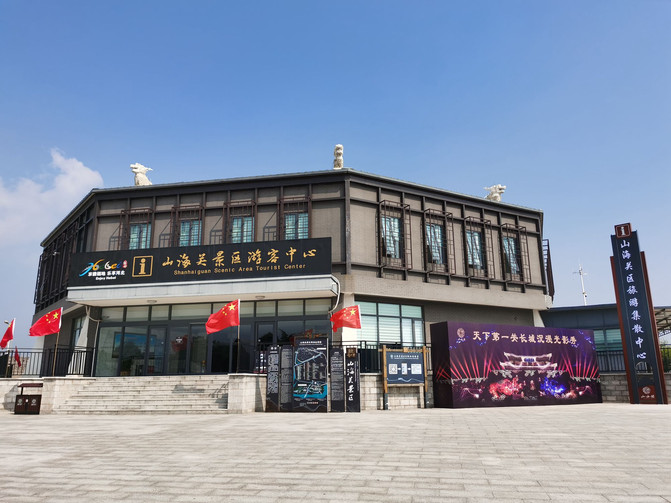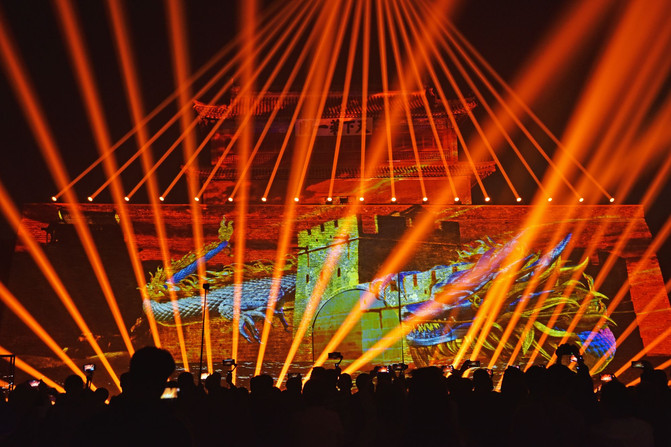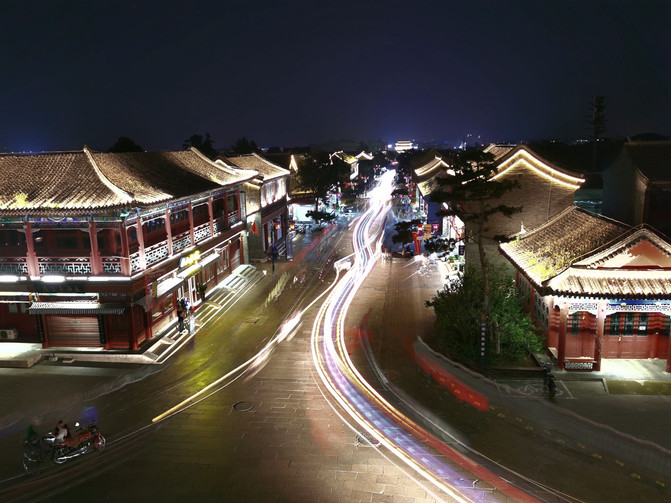
A Magical Trip to Shanhaiguan: Exploring History, Culture, and Cuisine
Hey there, fellow travelers! I’m thrilled to share with you my amazing two – day trip to Shanhaiguan, a place that combines rich history, stunning scenery, and mouth – watering cuisine.

1. The Great Wall Scenario Light and Shadow Show at the First Pass Under Heaven
The Great Wall, one of the symbols of Chinese civilization, is a must – visit destination. And the First Pass Under Heaven, located between the mountains and the sea, is the gem along the Great Wall. I first passed by here more than a decade ago and only had a half – day visit to the Old Dragon’s Head and the ancient city. This time, I took my time to fully experience its unique charm.
I chose to visit in autumn mainly to watch the scenario light and shadow show. Just a ten – minute walk from the train station, I reached the scenic area, and the sign of the light and shadow show was already up in front of the tourist center.
As evening fell, I saw beams of light shooting into the sky from the east in the ancient city. The show was about to start, so I queued up to enter. The square was bustling with people. After some effort, I found a good spot for taking pictures.

The show was a perfect combination of history, culture, and modern technology. Exquisite and gorgeous images were projected onto the city gate tower of the First Pass Under Heaven. There were five chapters in total:
- “The Majestic Pass between Mountains and Sea” and “The Stories of Heroes”: These two chapters presented the long history of the “First Pass Under Heaven”. From the chaos of the universe to the dawn of human civilization, through the dynasties of Song, Yuan, Ming, Qing, Qin, Han, Sui, and Tang, the show vividly showed the glorious history of battles and the touching stories of love and hatred. The Great Wall was not only a front – line defense but also a bridge of communication, where farming and nomadic civilizations blended, and Eastern and Western ideas clashed.
- “Inside and Outside the Pass”: It vividly demonstrated the local folk customs of this border city. As a crucial passage, people from different ethnic groups and with different customs came and went. The delicate and gentle style of the South and the bold and unrestrained style of the North were integrated here, making Shanhaiguan as inclusive and broad – minded as its name.
- “The Ten – Thousand – Li Great Wall”: This chapter focused on the grandeur of the Great Wall. With a series of magnificent pictures and dreamy light and shadow effects, the audience was deeply impressed. Standing under the atmosphere of the show, the First Pass Under Heaven, as the head of the Great Wall, looked even more imposing.
- “A Grand View of the World”: Chinese civilization is open and inclusive. Throughout more than three thousand years of history, the Great Wall has always been a link for communication rather than a barrier. Shanhaiguan is not only a place to view mountains and seas but also a gateway to the world.

After the show, there were many interactive projects under the city gate. The lights changed according to our movements, and the bricks in the light and shadow formed various shapes. It was like walking into a time – tunnel. When I climbed onto the city tower, the huge plaque of “The First Pass Under Heaven”, which was about 5 meters long and 1.5 meters high, was right in front of me. Each character was over one meter in size. It was said to be written by Xiao Xian, a Jinshi (successful candidate in the imperial examination) from Shanhaiguan during the Chenghua period of the Ming Dynasty. Standing on the tower, I could overlook the entire ancient city, which was even more charming under the night lights.

2. The Ancient City of Shanhaiguan: A Day and Night Adventure
After the light and shadow show, I started a night tour of the ancient city from the Zhendong Gate to the Ying’en Gate. In the center of the city, there was a bell and drum tower. The four gateways were inscribed with “Welcoming the Rising Sun”, “Facing the Capital”, “Connecting with the Sea”, and “Viewing the Mountains” respectively. The east of the bell and drum tower was the East Street; the west was the West Street; the south was the South Street; and the north was the North Street.
The bell and drum tower here was a rare three – in – one multi – functional building, combining the bell tower, the drum tower, and the Wenchang Hall. It was built during the Hongwu period of the Ming Dynasty by General Xu Da and had been repaired several times after being damaged. Standing on it, I could feel the passage of time as I watched the traffic below.
Shanhaiguan was an important trade route, and thus many escort agencies emerged. The Zhenyuan Escort Agency in the ancient city was one of the representatives. At its peak, it employed more than 50 escort masters. Many stories about chivalrous deeds were passed down here, and the custom of practicing martial arts was very popular. During the resistance against the Eight – Nation Alliance and the War of Resistance against Japanese Aggression, many heroes from the escort agencies fought bravely.
The ancient city was equally charming during the day. With a large number of shops on the streets, camels and horses could also be seen, indicating its prosperous trade. There was a sculpture near the Zhonglou that vividly reproduced the scene of people migrating to Northeast China. The customs and local snacks here combined the characteristics of Northeast China and Hebei, making me, a visitor from outside the pass, feel at home.
The Tian Mansion on the West Street, built in 1920, was the former residence of General Tian Zhongyu, one of the twenty – four top – ranking generals of the Beiyang government. It was a German – style building with a three – story brick structure, an arched high gate, and floor – to – ceiling windows, standing out in the ancient city.
Bicycles were very convenient in the ancient city, and some even had electric assistance. I could cycle around the main streets in just over an hour. There was also the Chengen Posthouse where Emperor Qianlong once stayed under the Ying’en Gate. There were numerous museums, memorial halls, and art galleries in the ancient city, offering a wealth of things to see.
The four main city gates of the ancient city each had their own characteristics. The Zhendong Tower on the east gate, the Ying’en Tower on the west gate, the Wangyang Tower on the south gate, and the Weiyuan Tower on the north gate. Cycling around the city, I could admire their unique styles. There were also many inns and homestays in the city, and the local snacks were diverse.
The Wang Family Courtyard, also known as the Shanhaiguan Folk Custom Museum, was a typical Ming and Qing – style quadrangle courtyard with three connected yards and 18 exhibition halls. It displayed the life scenes of the once – wealthy Wang family. The Wang family originated from Shanxi. They moved to Shanhaiguan to escape the war. After a series of legendary events, they settled here and became extremely rich through hard work and honest business. Inside the courtyard, from large furniture to small daily necessities, everything was on display, allowing us to experience the folk life of the Ming and Qing dynasties. There was also a hall dedicated to the story of Wu Sangui and Chen Yuanyuan. It was said that they once stayed here for a few days.
The General’s Office was the headquarters of the Shanhaiguan city defense. Since the position of the Shanhaiguan General was established in 1618, 23 generals had served here. Many famous historical figures such as Yuan Chonghuan, Xiong Tingbi, Sun Chengzong, Hong Chengchou, Zu Dashou, and Wu Sangui had left their footprints here. The General’s Office consisted of many buildings, and there were also other cultural buildings around it, forming a large – scale architectural complex.
3. The Jiaoshan Great Wall: A Natural Fortress
The Jiaoshan Great Wall, known as the “First Mountain of the Great Wall”, offers a magnificent view. It is about 3 kilometers north of the ancient city of Shanhaiguan, part of the Yanshan Mountains. With an altitude of 519 meters, it is the highest peak among the mountain barriers north of the city and the first mountain the Great Wall crosses after the Old Dragon’s Head.
The gate of the Jiaoshan Great Wall is in the shape of the Chinese character “山” (mountain), imitating the form of a Ming – Dynasty ancient castle. Built in the early Ming Dynasty under the supervision of General Xu Da, and with watchtowers and beacons added during the Jiajing, Longqing, and Wanli periods, the Great Wall here is very strategic. It has 5 watchtowers and 1 pass. The outer side of the wall is high, while the inner side is low, which is convenient for defense.
There was a Hanmen Pass on the Jiaoshan Great Wall, one of the ten important passes in Shanhaiguan. It was built in the early Ming Dynasty and consisted of a city tower and a platform. It was destroyed in the Qing Dynasty and later abandoned. Now, the blocked doorways can still be seen on the wall.
The Jiaoshan Great Wall is a typical example of a mountain – based Great Wall. Its structure is diverse and it is easy to defend but difficult to attack. The height and width of the wall vary according to the terrain. The shortest part is less than one meter, and the narrowest part is less than three meters. There are even “mountain – dangerous walls” on the steepest parts, using the cliffs instead of bricks. On the flat parts, the wall is more than ten meters high and over five meters wide.
After centuries of wind, rain, and snow, the Jiaoshan Great Wall was severely damaged. In the 1980s, with the call of “Love China, Repair the Great Wall”, it was well – restored. Climbing steps were built on and beside the wall for tourists. Standing on the Great Wall, I could overlook the ancient city of Shanhaiguan, and on a clear day, I could even see the sea.
There were two types of platforms near Shanhaiguan: the enemy platforms on the wall and the single platforms on the peaks inside and outside the wall (beacons). There was a Zhenlu Platform on the top of the east mountain in front of the Jiaoshan Great Wall. It was used for observation and sending signals. The Ming – Dynasty beacons had some improvements compared to the Han and Tang dynasties. Besides burning smoke and fire, cannons were also used.
The enemy platforms on the Jiaoshan Great Wall were built on cliffs. It was said that many such cross – wall enemy platforms were built when Qi Jiguang was the general of the Jizhen area. These platforms were very high and the terrain was dangerous. Many tourists were intimidated by the vertical iron ladder leading to them. Beyond the enemy platform, there was still a section of the Great Wall leading to a higher peak. There was also a Qixian Temple on the Jiaoshan Great Wall. In the Ming Dynasty, many scholars such as calligrapher Xiao Xian, Deputy Minister of the Ministry of War Zhan Rong, and Censor Zheng Ji once lived here to study. A Kui Star Pavilion was also built here, and it was known as the “Cradle of Shanhaiguan Culture”, adding a touch of literary flavor to the border Great Wall.
4. Accommodation: The Heyuan Courtyard
Accommodation is an important part of a trip. We stayed in a three – courtyard house near the Ying’en Gate, in front of which was the Chengen Posthouse where Emperor Qianlong once stayed. The simple and elegant quadrangle courtyard was exquisitely decorated. Each courtyard had its own style. It was neither overly luxurious nor lacking in grandeur, making people feel comfortable.
The owner named the courtyard “Heyuan” (Combined Courtyard). The character “合” (he) means both “inclusion” and “gathering”. In traditional Chinese culture, it represents a high – level pursuit. In this courtyard, friends and relatives can gather, and each room also provides private space.
There was a long space in the innermost courtyard with pine trees and bamboo planted on both sides. It made me imagine children playing here, such as playing hopscotch, skipping rope, throwing sandbags, or pushing iron hoops.
The interior of the courtyard was in a typical Chinese style. The main hall was solemn and elegant, a good place for receiving guests and having tea. The independent study was full of the charm of books. The courtyard also provided ancient costumes, so we could take pictures in Hanfu or cheongsam. The classical big bed, with its golden color, had a royal style. We joked that it was the “Dragon – Lying Bed”. After a good sleep on the comfortable zero – pressure mattress, we were ready to continue our journey.

5. Food in Shanhaiguan: A Gastronomic Delight
As a foodie, trying local cuisine is always a top priority. The barbecue and late – night snacks at the Heyuan Courtyard were unforgettable, and the lunch at the Holiday Hotel’s Jinyu Mantang was also mouth – watering. A glass of cherry wine and a table of special dishes welcomed us to start our food journey in Shanhaiguan.
The flaming snow – beef ribs, the nut – covered shrimps in a cloud – like mist, the glassy eggplant boxes that didn’t taste like eggplant at all, the fragrant chrysanthemum hot pot, the authentic roast duck set for 138 yuan, and a large plate of tender and spicy fish for only 48 yuan were all incredibly cost – effective. Even the modified Guoguan Zhaobing (a kind of staple food), which was not originally a local dish, was highly praised by my friend from Shijiazhuang.
After the big meal, I also tried local snacks. There was a Four – Street Baozi Shop near the Wang Family Courtyard. Since its opening in 1958, it has always strictly selected ingredients and maintained the traditional cooking method, becoming a well – known local brand. A plate of baozi, a plate of sausage, a few side dishes, and a bottle of Great Wall soda marked the perfect end of my trip to Shanhaiguan.
This two – day trip was rich and fulfilling. If I had one more day, I would love to visit the Old Dragon’s Head, the Meng Jiangnu Temple, and every museum in the ancient city. Shanhaiguan, with its profound historical heritage, amazing light and shadow show, majestic Great Wall, beautiful legends, and delicious food, is truly an excellent travel destination. I’m already looking forward to my next visit!






